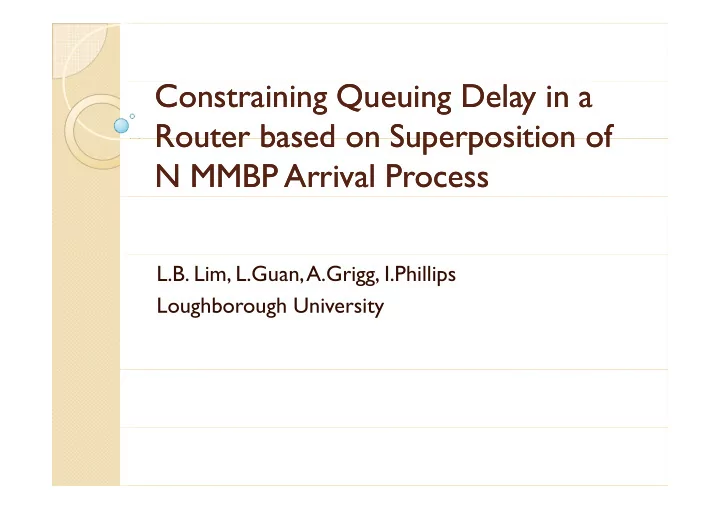

Constraining Queuing Delay in a Constraining Queuing Delay in a Router based on Superposition of Router based on Superposition of Router based on Superposition of Router based on Superposition of N MMBP Arrival Process N MMBP Arrival Process L.B. Lim, L.Guan, A.Grigg, I.Phillips Loughborough University Loughborough University
Outline Outline Outline Outline � Introduction � Introduction � DTH (Dynamic THreshold) Overview � Performance Evaluation � Conclusions � Conclusions � Future Work
Introduction Introduction Introduction Introduction Quality of Service (QoS) is very Quality of Service (QoS) is very • important and normally being measured through metrics such as: g Network delay • Packet loss • Throughput • Fairness • Network delay is critical for delay • sensitive applications; therefore pp constraining end-to-end delay is a key QoS requirement nowadays.
Network Delay Components Network Delay Components Network Delay Components Network Delay Components Propagation Delay Processing Delay Queuing Delay Jitter Delay Quality of Service y Transmission Delay Transmission Delay …… Loss
Queuing Delay Queuing Delay Queuing Delay Queuing Delay D l Delay D l Delay without control time
Queuing Delay Queuing Delay Queuing Delay Queuing Delay Delay Delay without ith t control try to control t t t l latency time � Propose a new approach to bound average queuing delay using dynamic queue thresholds i d l i d i h h ld mechanism.
DTH Overview DTH Overview DTH Overview DTH Overview • DTH (Dynamic THreshold) is a control DTH (Dynamic THreshold) is a control theoretic queue management scheme which aims to bound the average queuing delay in a core router. y • A closed-loop feedback control is used to adjust target queue threshold dynamically adjust target queue threshold dynamically based on the average queuing delay observed in the system. b d i h
DTH System Diagram DTH System Diagram DTH System Diagram DTH System Diagram
MMBP MMBP 2 Traffic Model MMBP MMBP-2 Traffic Model 2 Traffic Model 2 Traffic Model � N MMBP-2 is used to represent aggeregated Internet traffic formed by traffic flows from Internet traffic formed by traffic flows from various traffic classes (e.g. CBR, VBR, voice).
Analytical Model Analytical Model Analytical Model Analytical Model � Too complex to derive a closed-form function for relationship between delay and threshold, numerical analysis is used instead.
DTH Online Regulation DTH Online Regulation DTH Online Regulation DTH Online Regulation � Average queuing delay is g q g y calculated periodically and compared with required delay to get the delay delay to get the delay delta. � The target queuing delay g q g y for next time window is then estimated based on delay delta delay delta. � Queue threshold is then adjusted based on the j target queuing delay for the next time window.
Scenario 1: Different number of Scenario 1: Different number of sources sources N SCV MSE 1 0.1229 0.1599 2 0.1554 0.1895 3 3 0.3177 0.3177 0.3392 0.3392 4 0.3485 0.3642 5 0.3281 0.3406
Scenario 2: Different required delay Scenario 2: Different required delay Scenario 2: Different required delay Scenario 2: Different required delay Dr SCV MSE 5 0.3233 0.4392 6 0.2181 0.2279 7 7 0.1382 0.1382 0.1471 0.1471 8 0.2095 0.2233 9 0.3884 0.4649
Scenario 3: Different service rate Scenario 3: Different service rate Scenario 3: Different service rate Scenario 3: Different service rate β SCV MSE 0.60 0.3845 0.6324 0.65 0.3370 0.4225 0.70 0.70 0.2872 0.2872 0.2922 0.2922 0.75 0.2405 0.2655 0.80 0.4643 0.6223
Simulation Results Simulation Results Simulation Results Simulation Results � Queuing threshold is � Queuing threshold is movable to maintain queuing delay to its queuing delay to its specific target. � Packets are dropped P k t d d when queue length > queue threshold; packet th h ld k t loss event becomes i implicit feedback to the li it f db k t th sources to regulate its t transmission rate. i i t
Conclusions Conclusions Conclusions Conclusions � A discrete-time analytical model which � A discrete-time analytical model which uses N MMBP-2 to represent multi-class traffic is developed to derive relationship p p between queuing threshold and queuing delay. y � A control strategy with dynamic queue thresholds is used to control queuing q g delay at a specified value. � Packet loss event served as implicit p congestion indication to the sources in order to regulate the sending rates.
Future Work Future Work Future Work Future Work � Implement DTH mechanism into � Implement DTH mechanism into programmable network processor platform. � Performance analysis on a real-time y test-bed.
Th Th Thank Thank k k Y Y You You
Recommend
More recommend